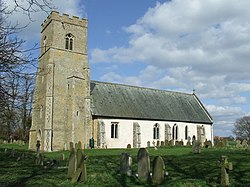Blo' Norton
| Blo' Norton | |
| Norfolk | |
|---|---|
 St Andrew's parish church | |
| Location | |
| Grid reference: | TM0179 |
| Location: | 52°22’30"N, 0°57’28"E |
| Data | |
| Population: | 251 (2011) |
| Post town: | Diss |
| Postcode: | IP22 |
| Local Government | |
| Council: | Breckland |
| Parliamentary constituency: |
South West Norfolk |
| Website: | Blo' Norton Parish Council |
Blo' Norton is a village and parish in the Guiltcross hundred of Norfolk, on the River Little Ouse, about 6½ miles west of Diss. The name is often recorded without the apostrophe, especially in older documents. The 2011 Census recorded the parish population as 251, a slight decrease on the 270 recorded in 2011.
Early history
Blo' Norton's unusual placename is reputedly derived from ‘Blae’, an old Old English word meaning both ‘cold’ and ‘blue’. The 'blue' could refer to the woad plant that grows in wetter areas and is a source of traditional blue dye. 'Norton' is a settlement on the north side of the river.
Bill Bryson mentioned the placename in his book Notes From A Small Island. The name was also briefly featured in an episode of the Channel 4 television show So Graham Norton.
There is evidence of people living in the area from Anglo-Saxon times, and perhaps from the Romano-British period. Aerial photographs show outlines of buildings and tracks that may be from the Romano-British period, near to Blo Norton Hall.
Parish church
The Church of England parish church of St Andrew was built in the 13th century, remodelled in the 14th century and restored in 1879. It is a Grade-II* listed building.[1]
The west tower has a ring of six bells. Thomas Osborn, who had bell-foundries at Downham Market in Norfolk and St Neots in Huntingdonshire, cast five of the bells including the tenor in 1794. John Warner & Sons of Cripplegate, London cast the treble bell in 1892.[2]
Blo Norton Hall

Blo Norton Hall is a timber-framed, moated Tudor manor house at the end of an avenue of lime trees west of St Andrew's church. It was enlarged in Elizabethan style in 1585. It is a Grade-II* listed building.[3]
In the summer of 1906 Virginia Woolf (1882–1941) stayed at Blo Norton Hall. The visit inspired her short story, "The Journal of Miss Joan Martyn".[4][5]
Blo' Norton and Thelnetham Fen
South of the village and along the river is the Blo' Norton and Thelnetham Fen Site of Special Scientific Interest, an important calcarous fen wetland site supporting rare plant species including black bog rush Schoenus nigricans and saw sedge Cladium mariscus.[6] The Little Ouse Headwaters Project manages part of this area as well as surrounding wetland areas such as Hinderclay Fen and Suffolk Wildlife Trust also has a reserve on part of the site.[7][8]
Prince Frederick Duleep Singh
Prince "Freddy" Frederick Duleep Singh (1868–1926) lived at Blo Norton Hall for the last 20 years of his life and is buried in St Andrew's parish churchyard. For this reason Blo' Norton is part of the Anglo-Sikh Heritage trail.
Prince Frederick designed the village war memorial in front of the church.
References
- ↑ National Heritage List 1077440: Church of St Andrew (Grade II* listing)
- ↑ Dawson, George (8 April 2011). "Blo' Norton S Andrew". Dove's Guide for Church Bell Ringers. Central Council of Church Bell Ringers. http://dove.cccbr.org.uk/detail.php?searchString=Blo%27+Norton&Submit=+Go+&DoveID=BLO+NORTON. Retrieved 1 December 2017.
- ↑ National Heritage List 1077439: Blo' Norton Hall (Grade II* listing)
- ↑ Squier, Susan M; DeSalvo, Louise A (Autumn–Winter 1979). "Virginia Woolf's The Journal of Mistress Joan Martyn". Twentieth Century Literature 25 (3/4, Virginia Woolf Issue): 237–269.
- ↑ "Blo' Norton". Literary Norfolk. http://www.literarynorfolk.co.uk/blo_norton.htm. Retrieved 1 December 2017.
- ↑ "Site Name: Blo' Norton and Thelnetham Fen". Natural England. Archived from the original on 8 May 2014. https://web.archive.org/web/20140508222742/http://www.sssi.naturalengland.org.uk/citation/citation_photo/1000633.pdf. Retrieved 31 January 2013.
- ↑ "Our sites". Little Ouse Headwaters Project. http://www.lohp.org.uk/our-sites. Retrieved 31 January 2013.
- ↑ "Thelnetham Fen". Suffolk Wildlife Trust. Archived from the original on 18 February 2013. https://web.archive.org/web/20130218202801/http://www.suffolkwildlifetrust.org/reserves-and-visitor-centres/thelnetham-fen/. Retrieved 31 January 2013.
Further reading
- Pevsner, Nikolaus (1962). North-West and South Norfolk. The Buildings of England. 2. Harmondsworth: Penguin Books. p. 92. ISBN 0-14-071024-8.
Outside links
| ("Wikimedia Commons" has material about Blo' Norton) |
- "Maharajah Duleep Singh". Anglo Sikh Heritage Trail. http://asht.info/anglosikh/479/maharajah-duleep-singh.html.
